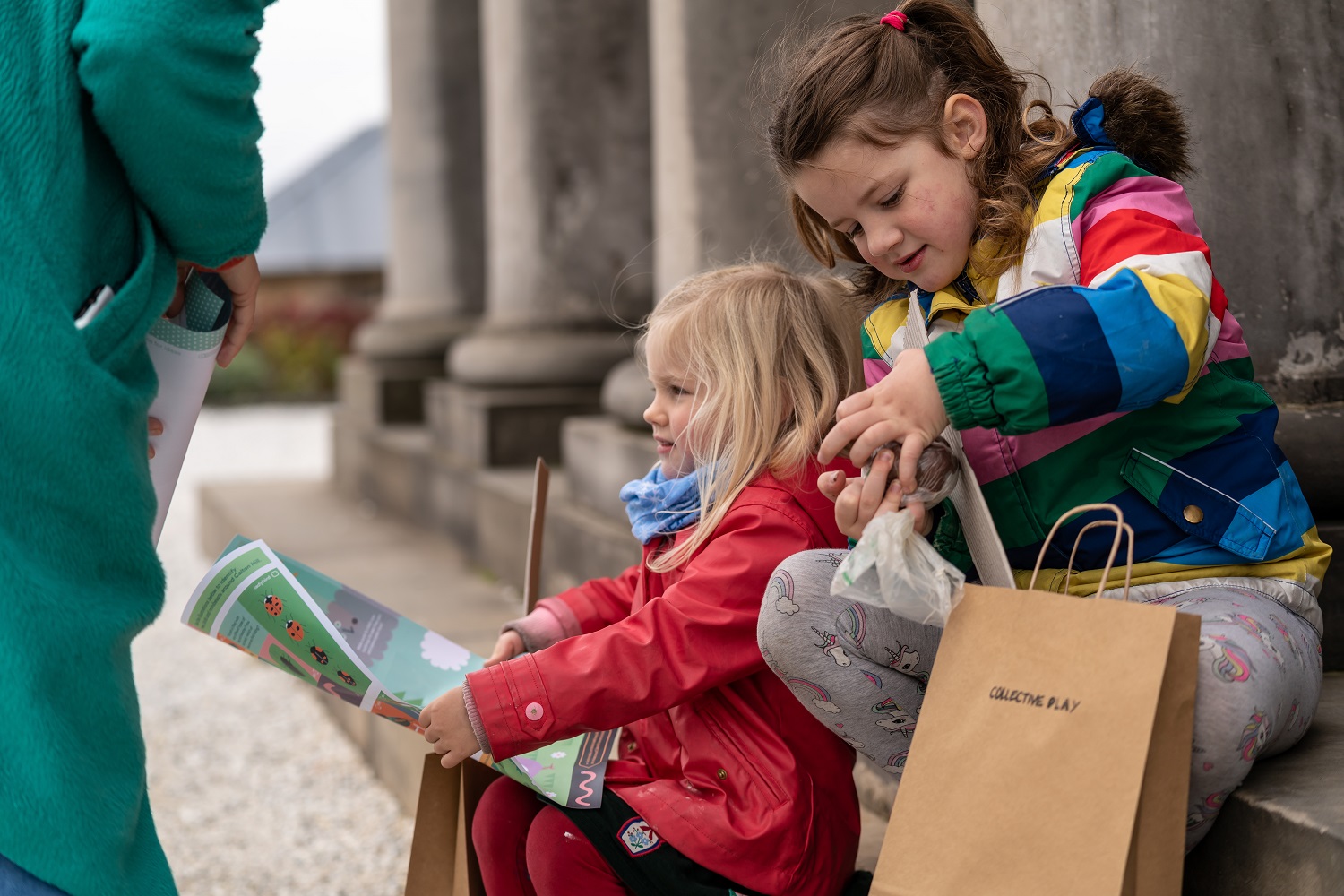What was your play pilot?
Collective Play is a weekend-long event for local children and families, which takes place on site at Collective twice a year in May and September. Activities during the weekend usually include artist-supported workshops, loose parts play, exhibition visits and other opportunities to be creative across Collective’s site.
This Autumn’s Collective Play, which was our pilot activity for the mentoring project, proved challenging to plan and produce, given the additional safety measures which needed to be considered and the changing restrictions. We were keen to keep the spirit of Collective Play, but adapted elements such as our loose parts play area, which is usually very collaborative with children sharing materials, to be offered instead as a pack for individual families to keep after use.
The indoor spaces at Collective are generally domestic-sized, and with social distancing measures in place, capacities were very limited. Instead, the weekend focused entirely on outdoor play, with the weekend titled ‘Children of the Hill’, and activities focused on exploring nature.
Local families were invited to book a timeslot, one household at a time, to come and collect:
- A pack of nature-themed ‘loose parts’ materials designed to encourage inventive, child-led play.
- A Children of the Hill fabric activity pouch designed by artist Holly White, which includes a short story set in the future, on a Calton Hill taken over by children along with materials used by the children in the story, such as seeds, clay and fabric.
- Three family friendly trails for exploring Calton Hill, including a brand new Nature Trail developed specifically for the event, to help families identify the plants, animals and minibeasts who make their home here.
Families would then take their pack out into the surrounding park, where there was plenty of space to play safely.
Budget
££
What would you consider your level of experience in creating playful interventions in museums prior to the project (1 being the least experienced and 5 being the most)?
3
Why did your organisation choose to take part?
With international tourism less possible, our site on the top of Calton Hill has felt like a very different place during lockdown. The usual sightseers have been replaced by local families, exploring the park and exercising.
As we reopened after lockdown and developed our Collective Play programme, we were keen to serve this growing local audience and offer families a fun, accessible and safe way to try new things. Our locality has a high percentage of multiple deprivation households who may not usually engage with cultural activity, and we see this as a unique moment to offer them something different. Playful interventions can be an accessible way in to exploring our programme and site for families who may not usually visit a museum.
What did you achieve?
The weekend was fully booked, with 164 people taking part over the weekend, in pre-booked, timed slots. Feedback from families was overwhelmingly positive, with comments such as:
- “We enjoyed pretty much everything! Fantastic resource packs, great family trails, beautiful graphics, friendly welcome, kids treated like human beings… All in, a fantastic few hours!”
- “The pack was well thought out and no wasteful or unnecessary items in it. Encouraged me to think about the hill as a place to play for children rather than just for a walk.”
- “I loved how informative it was. My little one really enjoyed the clay and the trail. I though the activity pack was really well done and beautiful. We really enjoyed our visit.”
Lessons learnt
The experience was invaluable in terms of organisational learning – it was an opportunity for us to try something different and experiment with new approaches, such as the walking trails, which will continue to be useful throughout this period of social distancing. Utilising the outdoor spaces on our site, and the surrounding park, meant that we were able to host greater numbers of visitors while maintaining social distancing and ensuring the safety of visitors and staff. There was clearly an appetite for this type of event, given the speed at which spaces were filled, and we were pleased to be able to offer this for our local community.
Though it was, at times, extremely challenging to plan an event without knowing how the changing restrictions may affect it’s delivery, we found that always having a plan A, plan B and plan C (for the different levels of COVID-19 restrictions) was a good way for us to ensure the event could go ahead safely.
Despite making adjustments, we managed to keep the essence of what Collective Play is: child-led play, opportunities for artists, and accessible ways in to our programme for local families. Keeping these key objectives at the front of our thinking when making our plan A, plan B and plan C (and D, E, F!) meant that the weekend still had the spirit of Collective Play.
Top tips
Don’t be afraid to change the plan, even at the last minute! This is especially true during the COVID-19 pandemic, when flexibility was essential to producing a safe event, but this advice also applies to any kind of play activity – let children lead the way and be flexible enough to follow their lead.
Where they take you is often far more interesting and exciting than wherever you thought you were going!
The Play in Museums in a Socially Distanced World project was made possible by the National Lottery Heritage Fund.
Categories: Play
Audience: Family

